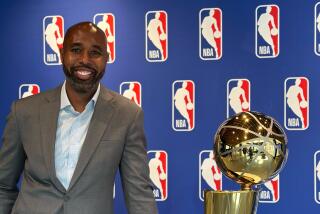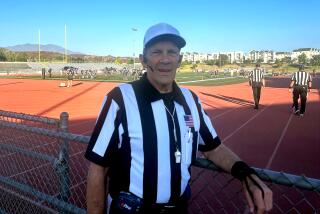TOUGH CALLS
- Share via
Death threats were nothing new to Kerry Fraser. Enduring twisted scare tactics is part of being an NHL official -- a job that challenges one’s body, will, mind and spirit -- but this one was different. It came from within the now-defunct St. Louis Arena and stopped the referee in his tracks.
As he left the ice for the first intermission of Game 6 of the 1986 Campbell Conference finals between the Blues and the Calgary Flames, a policeman grabbed Fraser and informed him of the call. The authorities warned Fraser to consider the gravity of the situation during the intermission, but he was undeterred.
“I said to the officer, ‘I’m going back out there,’ ” Fraser said. “ ‘He’d better be a good shot, because I’m a small target and I’m pretty quick.’ It didn’t really stay on my mind once I got out there. I just got into the game and the adrenaline started flowing. I had a job to do. What would I say, ‘No, call the game off, I’m not going back out there?’ ”
In the macho world of professional ice hockey, officials must be as fearless as the players. But while the tales of bravery among those who carry sticks are part of the game’s lore -- Toronto’s Bobby Baun scoring the Stanley Cup winning goal in overtime in 1964 while playing with a badly broken ankle best captures the culture of this sport -- the desire, raw athleticism and toughness of hockey’s officials is rarely broached.
It is routine for these men, 14 of whom are enshrined in the Hall of Fame, to receive a host of stitches between periods and race back to the ice. Getting struck by pucks and sticks is a regular occurrence. Taking a misplaced uppercut to the face when breaking up a fight is a right of passage. They describe concussions, broken bones and stints in physical rehabilitation in the casual manner office workers might discuss the travails of a rush-hour commute.
Few spectators pause while watching a game to assess the skating ability and agility of the referees and linesmen, who adroitly climb the boards, avoid interfering with the play and keep pace with some of the most conditioned athletes in the world within tight confines and unforgiving boards. There is no out of bounds or foul territory. Hockey officials toil within the very fabric of the game.
The pace of the sport has hastened immeasurably. Players have become masses of rippling muscle and fortified bone. The proliferation of instant replay and video review has amplified the demands of officiating. Yet, for the most part, the officials remain unseen on the ice -- and that is how they prefer it.
“There was an era of them doing their jobs when there was no videotape, so there was a lot less scrutiny,” Commissioner Gary Bettman said. “And what the era of videotape has shown is that their calls and non-calls -- and there are literally hundreds of them in the course of a game -- are right so much of the time.
“It’s not that they’re perfect, because nobody is, but they are closer to perfect than they are given credit for. What gets focused on is the one or two calls that may get missed, and what is unfair about that is, when that happens, it’s because somebody has had the ability to sit down for 30 seconds watching it in slow motion and watching it from four different angles. What our officials do on the ice, skating night in and night out, is simply incredible.”
Do not consider a career as a hockey official if the sight of blood causes you to recoil. A fear of needles or hospitals is a definite job hazard. The ability to avoid an oncoming puck speeding above 100 mph yet still view every skater on the ice is essential. And that is only the beginning.
“It’s a thankless job,” said Hall of Fame coach Scotty Bowman, whose criticism of officials resulted in countless fines during his career. “My brother was a referee, a good referee in the Quebec League, and he loved it. You’ve got to love it to do it.
“I thought he was crazy, but he didn’t care. You’ve got to have that police mentality -- you’ve got to be willing to punish people and you can’t worry about making friends and influencing people. That comes with the territory. And you’ve got to make split-second decisions on the ice with [players] making 20, 50 times what [officials] are and there are no home games. All that stuff must go through their minds.”
Every official can run off his own litany of injuries. In 1982, Hall of Fame defenseman Paul Coffey’s slap shot fractured the end off of Fraser’s fibula 10 minutes into a game. Fraser, who has been in the NHL for 26 years, finished working the game, went to the hospital and was out for six weeks. Two years ago a deflected shot shattered his cheekbone.
Mark Howe, playing for Philadelphia at the time, once fired a puck at Fraser’s head after a series of calls went against the Flyers. Fraser warned Coach Mike Keenan to yank Howe off the ice and calm him down, but, since the outburst was out of character for the defenseman, Fraser never reported the incident to the league.
“I was terribly wrong for doing that, and I should have been suspended,” Howe said. “But Kerry really gave me a break. He definitely saved me on that one.”
Despite it all, Fraser -- at 50 the oldest referee in the league and a veteran of more than 1,400 NHL games, refuses to wear a helmet -- and thus continues to take abuse for his perfectly styled coif from fans and players around the league.
“I’m sort of an old-school guy,” Fraser said. “From the beginning I was always a little player and had to stand up and be counted. I was kind of a junk-yard dog player, so I came into officiating right out of playing junior with the attitude of never letting the big guys know you’re hurt. So if I take a shot or get body-checked or get hurt, I’ll come up smiling because it’s built into me.”
That mentality is prevalent among Fraser’s officiating brethren as well. Last season, the league endured a rash of injuries to officials, with nearly 10 out due to injury at one point; the league employs 33 referees and 39 linesmen, with 13 replacements working mostly minor league games.
Andy Van Hellemond, who refereed 1,475 games, more than anyone else in league history, now serves as the NHL’s director of officiating, and is in charge of overseeing everything associated with the referees and linesmen from scheduling and travel to calling in replacements. Van Hellemond, who was elected into the Hockey Hall of Fame in 1999, is also at the vanguard of a sweeping evaluation system in which every official travels with a laptop computer and receives daily critiques via e-mail and video downloads.
Van Hellemond, 55, still feels the pain of his previous career. He broke his hand, broke three ribs and separated his sternum after a collision with Hall of Fame defenseman Larry Robinson along the boards. Van Hellemond was twisted awkwardly upon impact and spent five weeks in the hospital with a badly pinched nerve.
“I couldn’t feel my right leg for the longest time,” Van Hellemond said. “They would put pins and needles in my leg up to my hip and I didn’t feel a thing.”
Eventually, a chiropractic adjustment saved Van Hellemond’s career. He was also the first official to don a helmet, after finding himself unable to give a sensible reason not to wear one when questioned by pupils at a referee school (helmets were eventually grandfathered in and several veteran officials still do not wear them).
The occupation remains perilous despite major equipment advances since Van Hellemond entered the league. Officials used to wear only what amounted to soccer shin guards under their pants, but now wear a fully padded pant much like the players do. The elbow pads are more advanced, as are the chest protectors, but there is no absolute way to be protected from pain.
Linesman Pierre Racicot had nine stitches removed from his eye before a game at MCI Center this season. Referee Terry Gregson was struck in the side of his head by a puck during a game this season as well and needed medical attention, but has not missed a game since March 7, 1989, when he returned after a six-week absence from a broken collarbone.
“I’ve been fortunate with that stuff,” Gregson said. “In my 24 years doing this I’ve been lucky.”
More to Read
Go beyond the scoreboard
Get the latest on L.A.'s teams in the daily Sports Report newsletter.
You may occasionally receive promotional content from the Los Angeles Times.






